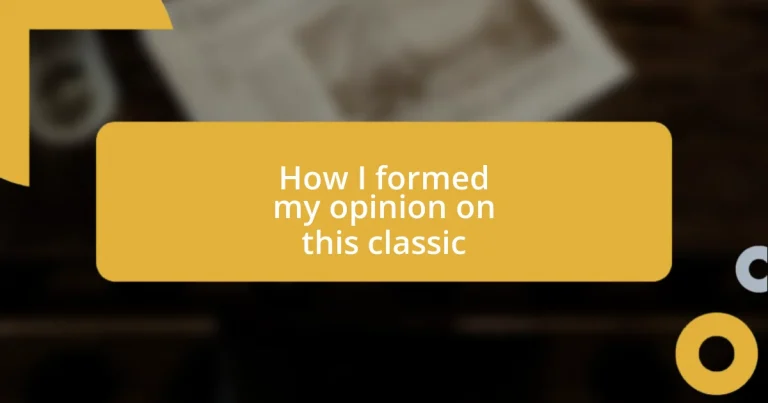Key takeaways:
- The narrator experiences a deep personal connection to the classic work, reflecting on how its themes resonate with their own life struggles, particularly around identity and resilience.
- Researching the historical context of the text enhances understanding, revealing how social norms, political climate, and the author’s background shape the narrative’s meanings.
- Engaging in discussions with others about the book introduces new interpretations, demonstrating that personal experiences can significantly influence one’s understanding of literature.

Understanding the classic work
When I first encountered this classic work, I was struck by its timeless themes that resonated with my own experiences. I vividly remember discussing it with friends over coffee, and we found ourselves debating the motivations of the characters – it was an electrifying exchange! Have you ever felt so deeply connected to the struggles of fictional characters that you began to reflect on your own life choices?
As I delved deeper, I realized the intricacies woven into the narrative. Each word seemed to hold a weight that demanded attention, making me ponder the author’s intention. I often found myself asking, “Why did the author choose this particular setting?” or “What message is really being conveyed through this character’s journey?” These questions kept me engaged, leading to a wonderfully enriching experience.
There was a moment when I read a specific passage that felt like a revelation, almost as if the author was speaking directly to me. This connection confirmed that classics, with their layered meanings and emotional depth, endure because they provoke thought and evoke feelings. Isn’t it amazing how literature can transcend time and space, touching our hearts in the most unexpected ways?
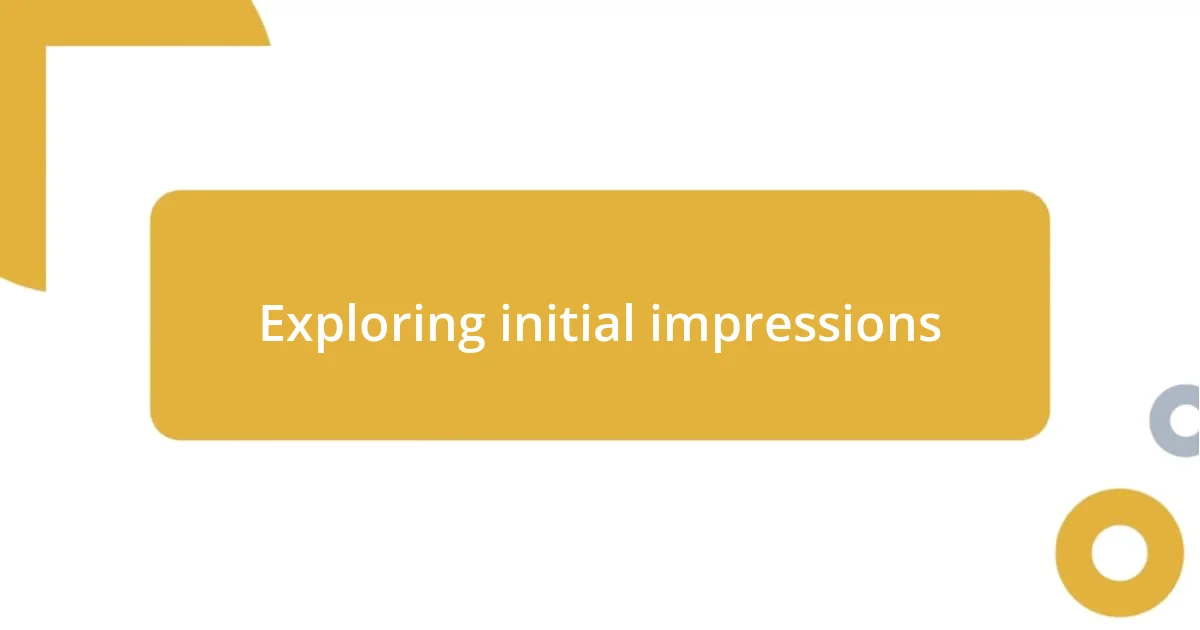
Exploring initial impressions
It’s fascinating how initial impressions can shape our understanding of a classic work. My first encounter was during a chilly winter evening, sitting by a crackling fire. The atmosphere was perfect; the book felt like an old friend as I began to wrap myself in its world. I remember noting how the characters captured my attention right away, each revealing hints of their complexities from the very first pages.
- The writing style immediately drew me in—its lyrical quality created a rhythm that was irresistible.
- I was intrigued by the protagonist’s struggle; it mirrored some of the challenges I faced at that time in my life.
- There was a distinct moment when a character made a choice that shocked me, sparking hasty contemplation of my own decisions.
- My surroundings faded away as I lost myself in the narrative, completely engrossed in its beauty and uncertainty.
Reflecting back on those early moments, I realize how they’ve indelibly colored my perspective and appreciation for the text. There’s something almost magical about those first sensations, isn’t there?
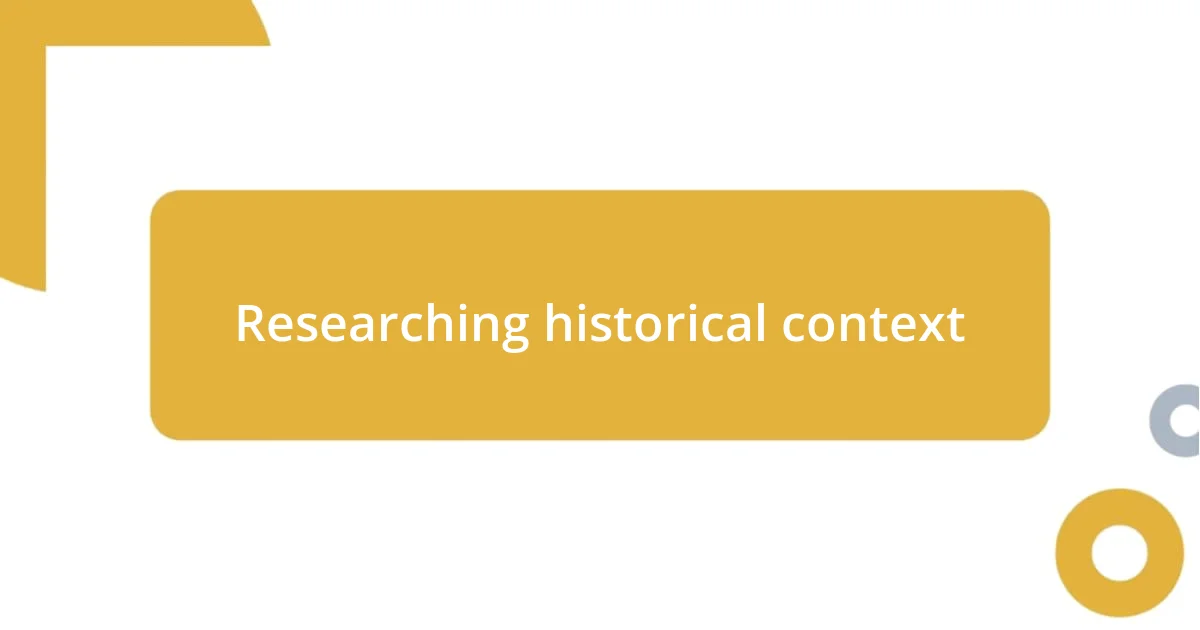
Researching historical context
When I began to research the historical context of this classic, it opened up a fascinating window into the world the author inhabited. I remember feeling intrigued by the social norms and political climate of the time; it felt like piecing together a puzzle where each piece represented a different aspect of the narrative. Understanding these elements enriched my reading experience, revealing layers of meaning that I hadn’t noticed before.
In one particular instance, I read about the author’s life during the period they wrote this work. It painted a vivid picture of their struggles and triumphs, making me realize how deeply personal experiences influenced the narrative. I couldn’t help but reflect on how my own environment shapes my opinions and choices today, forever tied to the world I live in.
Diving into the historical context, I felt an overwhelming connection to the cultural references and thematic elements rooted in that era. These insights not only illuminated the author’s intentions but also prompted me to think about how history continues to shape our storytelling. Have you ever noticed how a classic can act as a lens through which we understand not just the past, but also our present?
| Aspect | Historical Context |
|---|---|
| Social Norms | Perceptions of gender, class, and morals prevalent during the time |
| Political Climate | Influences of significant historical events on the narrative |
| Author’s Background | Personal experiences and their impact on the work |
| Cultural References | Elements from the period that resonate within characters and themes |
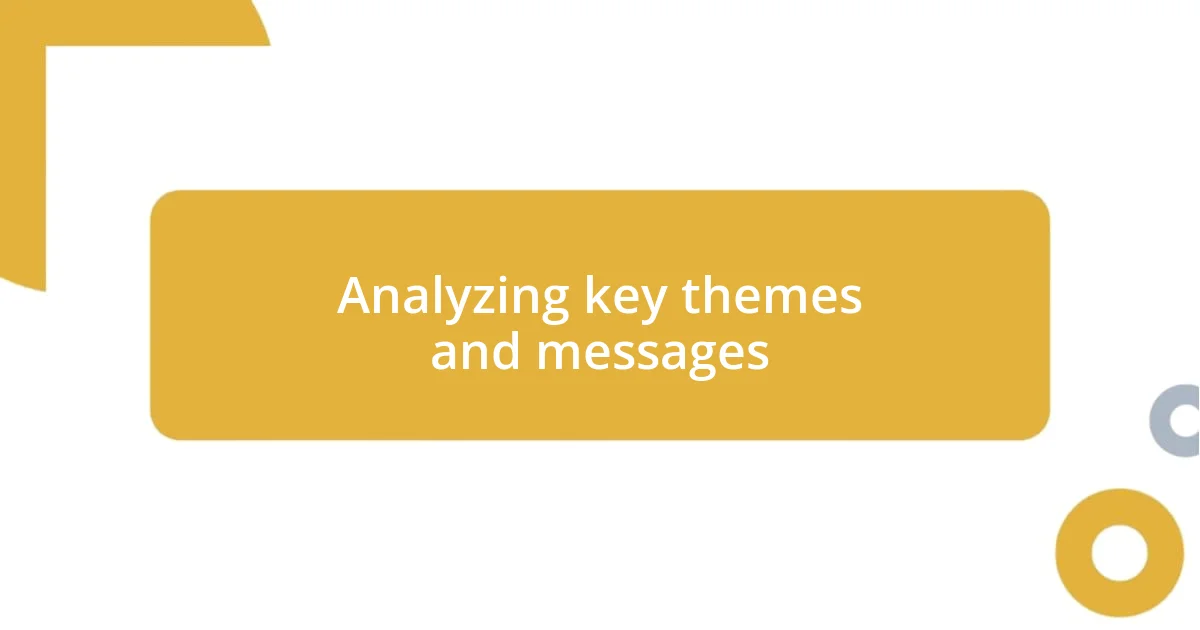
Analyzing key themes and messages
As I delved deeper into the text, certain themes emerged that resonated profoundly with my own life experiences. One dominant theme that struck me was the struggle for identity. I remember being in my late teens, trying to define who I was in a world that felt overwhelmingly complex. The protagonist’s journey echoed my own, filled with moments of doubt and self-discovery. It’s striking how literature can mirror our inner battles so closely; have you ever found yourself relating to a character’s search for self?
Another key message that caught my attention was the exploration of resilience in the face of adversity. I vividly recall a tough period in my life when it felt like obstacles were piling up, much like those faced by the characters. Their determination to navigate challenges inspired me, revealing the importance of perseverance. I often ask myself, what would I do in their shoes? That question not only challenges my outlook but also drives home the message that our struggles can lead us to unexpected strengths.
Lastly, the theme of interconnectedness between characters struck me like a light bulb moment. It made me reflect on my own relationships and the impact we have on one another. I think back to a time when a friend’s words uplifted me at just the right moment, reminding me how support shapes our journeys. Seeing these dynamics play out in the narrative reinforced my belief that we are all intertwined in our stories, don’t you think? This connection ultimately adds richness to the text, making it not just a story but a shared experience of human emotion and understanding.

Comparing different interpretations
The beauty of literature lies in its ability to be interpreted in myriad ways, and I often find myself considering how personal experiences shape our understanding of a classic. For instance, when I first read this book, my interpretation was heavily influenced by my own upbringing. I viewed the characters through the lens of my childhood experiences, which may differ significantly from someone who grew up in a different social backdrop. Isn’t it fascinating how our unique stories can color our perception of a text?
Each interpretation reveals a new facet of the narrative, much like how a diamond sparkles differently under various lights. I remember discussing the classic with friends from diverse backgrounds, and each person’s analysis opened my eyes to perspectives I hadn’t previously considered. Their insights were a reminder of how stories can resonate across different cultures, making the reading experience richer and more inclusive. Wouldn’t it be incredible if more conversations about literature celebrated these varied interpretations?
As I compare different interpretations, I’ve realized that certain themes resonate differently based on our personal journeys. One friend shared how she found solace in the protagonist’s resilience, while another struggled to relate because of their contrasting experiences with adversity. Reflecting on their views made me ponder: how do our individual trials shape our engagement with a story? I believe understanding these distinctions enhances not only our appreciation of the text but also deepens our empathy for each other’s narratives. The depth of interpretation is, after all, what keeps great literature alive and relevant through generations.
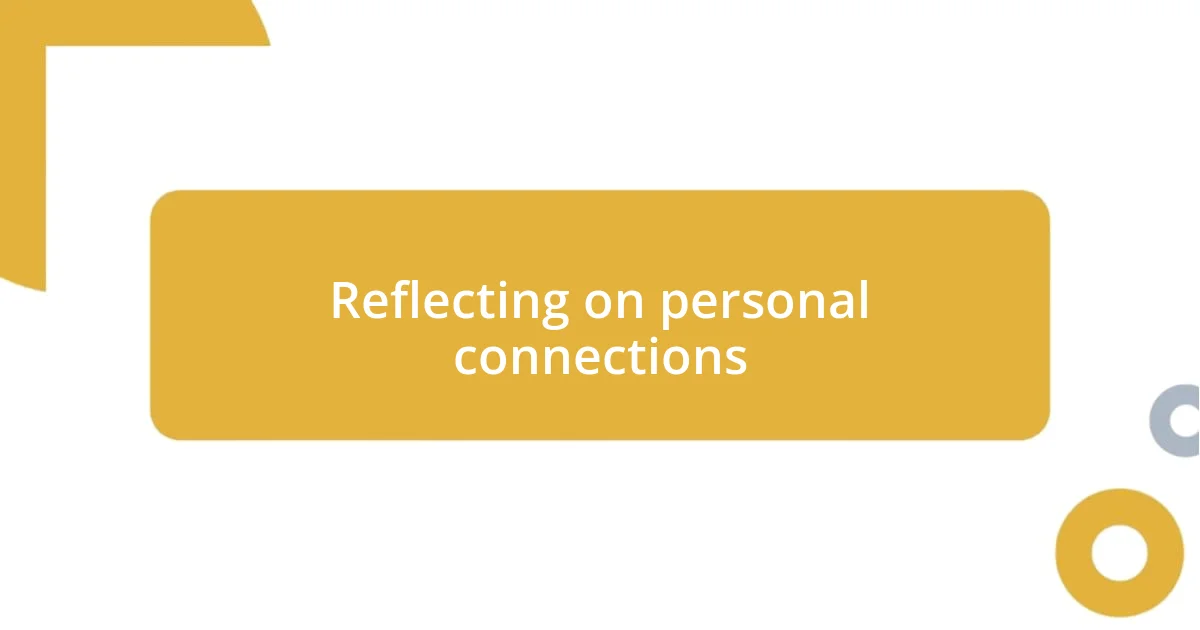
Reflecting on personal connections
Reflecting on personal connections has always been a vital aspect of my reading experience. I think back to a particular summer when I first read this classic. I was grappling with a profound sense of loss after a close family member passed away. The protagonist’s journey through grief mirrored my own struggles, making each page feel like a conversation with an understanding friend. Have you ever picked up a book at just the right moment in your life?
My connection to the characters often feels personal—not just abstract figures in a story. I remember how the friendships within the narrative reminded me of some of my own, particularly a bond I shared with a high school friend who helped me navigate through tough times. The ways they leaned on each other in the text spoke to how we lean on our loved ones when life becomes difficult. It’s incredible how literature can illuminate our real-life relationships; don’t you think?
In moments of reflection, I realize how the emotional arcs of characters can evoke a cascade of memories. A vivid example is when the protagonist faced betrayal; it took me back to my own experience with a friend who turned their back on me. The lingering pain from that relationship helped me appreciate the story’s emotional depth, as well as instill a sense of empathy for those grappling with similar betrayals. How do our past experiences shape the way we connect with fictional narratives? Those questions often lead me to richer insights about myself and the world around me.

Forming a nuanced opinion
Forming a nuanced opinion requires a willingness to explore complexities beyond the surface. I remember my initial reaction to this classic felt simplistic; I was swept away by the plot but didn’t grasp the subtleties until much later. It hit me during a book club discussion when one member unearthed a small detail—a seemingly trivial moment—that altered our understanding of the protagonist’s motivations. Have you ever realized that something you thought was obvious is only a tiny piece of a larger puzzle?
I’ve come to appreciate that forming an opinion is often a journey, not a destination. There was a time when I clung firmly to my original views, but over time, exposure to other interpretations made me reevaluate my stance. One evening, while sharing thoughts with a mentor who had studied this classic in-depth, I was intrigued by her analysis of the social commentary woven into the story. Her insights challenged my perspectives and spurred a deeper reflection on the themes of identity and belonging. It’s amazing how one dialogue can shift your entire viewpoint, isn’t it?
Nuance often emerges when we invite multiple viewpoints into our discourse. When I revisited the text, I made notes of my evolving thoughts, jotting down questions that sparked further curiosity. One particularly invigorating debate I had with a friend revolved around the ethical dilemmas faced by the characters. This conversation made me recognize that my initial takeaways were incomplete; I discovered ethical layers I hadn’t considered. How often do we limit our understanding by not engaging with others? Embracing differing opinions enriches the conversation and ultimately leads to a fuller grasp of the narrative’s depth.











